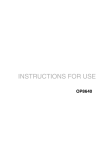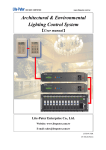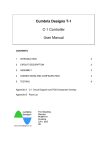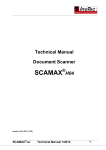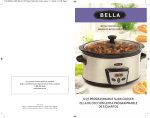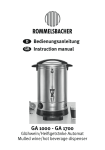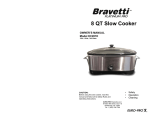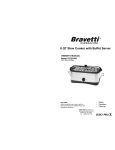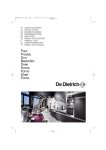Download Asko OP8620 Operating instructions
Transcript
99646641 EN - 06/08 INSTRUCTIONS FOR USE OP8620 Instructions for use Pyrolytic oven Dear customer, Thank you for choosing this quality product from ASKO. We hope it will meet all of your expectations and full fill your needs for many years to come. The Scandinavian design is a combination of clean lines, everyday functionality and high quality. This is the hallmarks for all of our products and this is why they are so highly appreciated all over the world. To get the most out of your new ASKO product, we recommend that you read the installation and operating instructions before using the machine. Safety Safety recommendations This appliance is intended for Domestic Cooking use and should be used in accordance with the information and instructions included within this manual. Any deviation from this may result in damage or personal injury. — This oven was designed for use by private persons in their homes. It is intended solely for cooking foodstuffs. This oven does not contain any asbestos-based components. — The appliance is not intended for use by young children or infirm persons unless they have been adequately supervised by a responsible person to ensure that they can use the appliance safely. — Young children should be supervised to ensure that they do not play with the appliance. Accessible parts will become hot when in use. To avoid burns and scalds children should be kept away. — Do not use a steam cleaner to clean a hob, oven or range. — Do not spray aerosols in the vicinity of the appliance when it is in operation. — Accessible parts will become hot when in use. To avoid burns and scalds children should be kept away. — Always turn the grill off immediately after use as fat left there may catch fire. — When you receive the appliance, unpack or have it unpacked immediately. Give it an overall inspection. Make note of any concerns or reservations on the delivery slip and make sure to keep a copy of this form. — Your appliance is intended for standard household use. Do not use it for commercial or industrial purposes or for any other purpose than that for which it was designed. — Do not modify or attempt to modify any of the characteristics of this appliance. This would be dangerous to your safety. — Never pull your appliance by the door handle. — Before using your oven for the first time, heat it up while empty for approximately 30 minutes. Ensure that the room is sufficiently ventilated. You may notice a particular odour or a small amount of smoke. All of this is normal. — During cooking, ensure that the door of your oven is firmly closed so that the seal can properly fulfil its function. — When in use, the appliance becomes hot. Do not touch the heating elements located inside the oven. You are at risk of incurring serious burns. — When inserting or removing your dishes from the oven, do not bring your hands near to the upper heating elements; use insulated cooking mitts. — After cooking, do not touch the cookware (grid, turnspit, etc.) with bare hands — Never place aluminium paper directly in contact with the bottom element (See the “Description of your oven” chapter), the accumulated heat could cause deterioration of the enamel. — Do not place heavy items on the open oven door; ensure that children cannot climb or sit on it. — To avoid damaging the control panel of your appliance, do not leave the door open when the oven is functioning or still hot. — The oven must be turned off for all attempts to clean the cavity. — Intensive and prolonged use of the appliance may require additional ventilation achieved by opening the window or increasing the power of the mechanical fan. In addition to the accessories provided with your oven, only use dishes that are resistant to high temperatures (follow manufacturer’s instructions). — After using your oven, ensure that all the controls are in the off position. During use some external parts of this appliance become hot. They can remain hot for some time after the oven has been turned off. Care should be taken to avoid burns.Children should be kept away at all time during use and in the cool down periods to safeguard against burns. Safety Care for the environment — This appliance’s packing materials are recyclable. Recycle them and play a role in protecting the environment by depositing them in municipal containers provided for this purpose. — Your appliance also contains many recyclable materials. It is therefore marked with this logo to indicate that used appliances must not be mixed with other waste. Recycling of the appliances organised by your manufacturer will thus be undertaken in optimum conditions,in accordance with European directive 2002/96/CE relative to electrical and electronic equipment waste. Consult your city hall or your retailer to find the drop-off points for used appliances that is nearest to your home. — We thank you for your help in protecting the environment. Warnings Warnings Installation should only be performed by qualified installers and technicians. This appliance complies with the following European directives: - Low Voltage Directive 73/23/CEE modified by directive 93/68/CEE for attribution of CE approval. - Electromagnetic Compatibility Directive 89/336/CEE modified by directive 93/68/CEE for attribution of CE approval. - CE Regulation 1935/2004 concerning materials and objects designed to come into contact with foodstuffs. Keep this user guide with your appliance. If the appliance is ever sold or transferred to another person, ensure that the new owner receives the user guide. Please become familiar with these recommendations before installing and using your oven. They were written for your safety and the safety of others. Ensure the appliance is switched off before replacing the lamp to avoid the possibility of electric shock. Accessible parts will become hot when in use. To avoid burns and scalds children should be kept away. Recommendations Please read these instructions before installing and using your oven. The oven has been designed for domestic use only for cooking food. No asbestos has been used in its construction. Using for the first time Before you use your oven for the first time, leave it empty and, with the door closed, turn it on to maximum temperature and let it heat up for 15 minutes. This "runs the oven in". During this time there may be some smell from the mineral wool that insulates the oven and there could be some smoke. This is perfectly normal. Normal use - Always close the door properly. The oven is fitted with a seal designed to work with a closed door. - Never lean or let anyone sit on the oven door when it is open. - The oven parts and accessories can become hot when the door is left partially open and the grill on. Always keep children at a safe distance. - When the oven is on it will get hot. Take care not to touch the heating elements inside the oven. 4 - Always protect your hands with oven gloves or something similar when removing food, accessories or containers from the oven. - Do not line your oven with kitchen foil. The metal will increase the heat produced and could ruin the food and damage the enamel. - Before carrying out the pyro-cleaning of your oven, be sure to remove all oven accessories and wipe away major spillage. - Do not use a steam or high-pressure cleaner. - During the cleaning cycle accessible surfaces become much hotter than during normal cooking. Keep children at a distance. - Always check that the oven is off before you clean the inside. - For your safety your oven is equipped with an AUTOMATIC STOP should you inadvertently forget to turn off your oven. After 10 hours' operation, the AS (Automatic Stop) function is activated and your oven stops heating. AS is displayed in place of the time and a series of 2 successive pips is sounded for a certain time. Contents Recommendations Using for the first time Normal use Contents Your oven, how it works Oven features Introduction to the programmer Accessories Anti-tip safety shelf Multi-purpose baking tray (reserved for pastries) Multi-purpose baking tray (dripping pan) 45 mm multi-purpose dishFully accessible sliding rail system Child safety Safety activation Open with safety engaged Safety deactivation Using your appliance Using the programmer How to set the time Immediate cooking Programmed cooking Cooking with immediate start and programmed duration Cooking with delayed start and chosen cooking end time Using the timer function Oven cooking modes Circulating heat* Combined heat Fan grill Grill high Conventional ECO* Warming oven Defrosting 4 4 4 5 6 6 7 8 8 8 8 9 9 9 9 9 10 10 10 11 12 Caring for and cleaning your oven Perform a pyrolysis Immediate pyrolysis Delayed pyrolysis Cleaning the outer surfaces Cleaning the door (model WITH PYROLYSIS function) Disassembling the door Troubleshooting What if… Installer's information Connecting up Housing General maintenance Changing the light bulb 17 17 17 18 19 19 19 21 21 22 22 23 24 24 12 13 14 15 15 15 15 15 15 16 16 16 5 Your oven, how it works Oven features 1 2 3 4 5 6 1 Programmer 2 Temperature selector switch 3 Function selector switch 4 Light 5 Wire shelf supports Your oven, how it works Introduction to the programmer 1 Time and cooking time display 2 Locked door indicator 3 ECO cooking indicato 4 Timer display 5 Cooking end time indicator 6 Cooking time indicator 7 Time setting buttons 8 Selection button (cooking time and time) 9. Temperature display 1 2 3 4 9 5 6 8 7 7 Accessories Anti-tip safety shelf BACK FRONT Food can either be placed on the shelf in a dish or cake tin for cooking or browning. This should be used for grilled meat (which should be placed directly on it). Multi-purpose baking tray (reserved for pastries) This tray has a raised edge and can be used for baking pastries (choux buns, meringues, small cakes, flaky pasties, etc). Inserted in the runners under the shelf, it catches the cooking juices and fat from grilled meat. It can also be used half-filled with water as a double boiler. Joints should not be cooked in this tray uncovered because fat could spit all over the oven sides. Multi-purpose baking tray (dripping pan) This is used to catch the cooking juices and fat from cooking carried out in the high grill or pulsed grill settings. It can also be used as a cooking dish for suitably sized joints (for example: a chicken surrounded by vegetables, at medium temperature). Inserted under the shelf,this pan catches cooking juices and fat from grilled food. It can also be used half filled with water as a double boiler. 8 Accessories 45 mm multi-purpose dish Fully accessible sliding rail system Thanks to the new sliding rail system with support (fully accessible) handling food is more practical and easier as the trays can be effortlessly removed for simpler handling. The trays can be completely removed, providing full access. Their stability ensures that food can be handled safely, reducing the risk of burns. This means that you can take food out of the oven far more easily. The drip tray at the bottom of the oven collects the juice and fat from roasting, and can be used halffilled with water as a bain-marie. Do not place meat or poultry directly on the drip tray for roasting. This would inevitably produce splashes and dirty the sides of the oven. Child safety Safety activation - Open the door. - Press the switch on the panel until the system is engaged and then close the door. Open with safety engaged - Press the lever and then open the door. Safety deactivation - Open the door and press the switch on the panel. Warning Remove the sliding rail system before starting a PYROLYSIS. 9 Using your appliance Using the programmer How to set the time 1 Press and hold the “ ” button for a few seconds until the display starts flashing, then release. When plugged in The display flashes 12:00. Audible beeps indicate that it is now possible to set the time. Set the time by pressing the + or – buttons (holding your finger on the button allows you to scroll through the numbers rapidly). Adjust the clock setting with the + and – buttons. Press the “ ” button to confirm. Example: 12H30 Press the “ ” button to confirm. The display stops flashing. 2 To set the time on the clock The function selector switch must be in the 0 position. Warning If there is no confirmation from the “ ”, button, the time is recorded automatically after a few seconds. 10 Using your appliance Immediate cooking The programmer should display only the time. It should not be flashing. 1 Turn the function selector to the position of your choice. Example: position . 2 Place your dish in the oven based on the recommendations provided by the cook book. After these steps, the oven heats up and the temperature indicator flashes. A series of beeps will sound when the oven reaches the selected temperature. The temperature stops flashing. To stop this heating, return the function selector to 0. Warning After a cooking cycle, the cooling fan continues to operate for a period of time in order to guarantee optimal oven reliability. Your oven recommends the optimal temperature for the chosen cooking mode. It is, however, possible to adjust the temperature by pushing the selection lever towards + or –. Warning All types of cooking are done with the door closed. 11 Using your appliance Programmed cooking Cooking with immediate start and programmed duration 1 Select the desired cooking mode and adjust the temperature. 2 Press the “ ” button until the cooking time indicator starts to flash “ ”. The display flashes 0:00 to indicate that you can now adjust the setting. After these three steps, the oven heats up: A series of beeps will sound when the oven reaches the selected temperature. At the end of cooking (end of programmed time), - the oven turns off, - the cooking time indicator and 00:00 both flash, - a series of beeps sounds for a few minutes. Press any button to stop the beeping. The display shows the time once again when the function selector switch is returned to 0. 3 Press the + or – buttons to set the desired time. Example: 30 min. cooking time. The cooking time is automatically recorded after a few seconds. The cooking time display stops flashing. The countdown of the cooking time begins immediately after it has been set. 12 Using your appliance Cooking with delayed start and chosen cooking end time Cooking with delayed start and chosen cooking end time After setting the cooking time, press the “ ” button until the end of cooking indicator flashes “ ”. The display flashes to indicate that you can now adjust the setting. 1 At the end of cooking (end of programmed time), - the oven turns off, - the cooking time indicator and 0:00 both flash, - a series of beeps sounds for a few minutes. Press any button to stop the beeping. 2 Press the + or - button to set the desired cooking end time. Example: end of cooking at 13:00. The display shows the time once again when the function selector switch is returned to 0. The light inside the oven turns on when cooking starts and goes out when cooking stops. The cooking end time is automatically recorded after a few seconds. The cooking end time display stops flashing. After these 2 steps, the oven heating is delayed so that cooking ends at 13:00. 13 Using your appliance Using the timer function Your oven’s programmer can be used as an independent timer that allows you to count down a time without operating the oven. In this case, the timer display has priority over the clock display. 1 Press the “ ” button until the timer symbol begins flashing. –> 0.00 and a small hourglass both flash. 2 14 Adjust the chosen time by pressing the buttons + or –. 3 Press the “ ” to confirm, or wait for a few seconds. The display stops flashing after a few seconds and the timer starts working, counting down the time in seconds. Once the time has expired, the timer emits a series of beeps to notify you. Press any button to stop the beeping. Warning It is possible to change or cancel the timer at any time. Oven cooking modes Circulating heat* (recommended temperature 180°C min. 35°C max. 235°C) • Cooking is by a heating element at the bottom of the oven and the oven fan. • Rapid temperature increase: Some dishes can be placed in the oven while it is still cold. • Recommended to retain moisture in white meat, fish, vegetables. For cooking multiple items on up to 3 levels. Fan assisted base (recommended temperature 205°C min. 35°C max. 275°C) • Cooking controlled by the bottom element combined with a slight dose of the grill and the fan. • Cooking heat from the bottom with a small amount of heat from the top. • Place the grid on the lowest shelf support. • Recommended for moist dishes (quiches, juicy fruit tarts, etc...). The crust will be thoroughly cooked on the bottom. Recommended for dishes that rise (cakes, brioche, kugelhopf...) and for soufflés that will not be hampered by a crust formed on the top. Combined heat (recommended temperature 205°C min. 35°C max. 275°C) • Cooking is controlled by the upper and lower heating elements and by the fan. • Rapid temperature increase: Some dishes can be placed in the oven while it is still cold. • Recommended for meats, fish and vegetables, preferably placed in a terracotta dish. Fan grill (recommended temperature 200°C min. 180°C max. 230°C) • Cooking controlled, alternately, by the upper element and by oven fan. • Preheating is unnecessary. Roasts and poultry are juicy and crispy all over. • Slide the drip tray onto the bottom shelf support. • Recommended for all poultry and spit roasts, to thoroughly cook legs and large cuts of beef. To keep fish steaks moist. Grill high (recommended temperature 275°C min. 180°C max. 275°C) • Cooking done by the upper element. • Cooking done by the upper element. • Recommended for grilling chops, sausages, toast or prawns, placed on the grid. Conventional (recommended temperature 240°C min. 35°C max. 275°C) • Cooking done by the upper and lower elements. • After preheating, you will cook most of your dishes, recommended for making sure white meat, fish, and vegetables stay moist. 15 Oven cooking modes ECO* (recommended temperature 200°C min. 35°C max. 275°C) • Cooking controlled by the upper and lower heating elements. • This position allows for energy savings while preserving the quality of the cooking. • The ECO position is used for energy label performance. • All cooking is done without preheating. Warming oven recommended temperature 80°C min. 35°C max. 100°C) • Heat regulated by the upper and lower elements with use of fan. • Recommended for leaving breads to rise (keeping temperature below 40°C), keeping dishes warm and thawing food. Defrosting (recommended temperature 30°C min. 30°C max. 50°C) • You can use your oven for defrosting, with just a limited amount of heat as the fan which circulates the air around the oven accelerates the exchange of temperatures between the dish and the appliance. • Recommended for defrosting fragile foodstuffs (strawberries and raspberries etc.). By slightly increasing the temperature you can defrost foodstuffs to be cooked immediately afterwards (meat, etc.). • Take care that you do not "overdefrost" the food, leading to it being partially cooked. Meat should be placed on the oven shelf on the second level to avoid it coming into contact with the juices produced during defrosting (placing the dripping pan on the first level). * Program(s) used to obtain the results indicated on the energy label in accordance with European standard EN 50304 and European Directive 2002/40/CE. 16 Caring for and cleaning your oven Perform a pyrolysis Immediate pyrolysis 1 2 Remove the grids and trays from the oven and clean any major spill residue. Check that the programmer is displaying the time of day and that it is not flashing. The symbol displays in the programmer to indicate that the door is locked. When pyrolysis finishes, 0:00 starts flashing. You can choose 2 durations of pyrolysis: pyrolysis lasting 1 hour 30 minutes. To return to the time of day, set the function selector to stop. pyrolysis lasting 2 hours. 3 Turn the function selector to the desired pyrolysis setting. 4 When the oven is cool, use a damp cloth to remove the white ashes. Example: 1 hr 30 mins. When pyrolysis starts, the symbol displays in the programmer as well as the duration of the pyrolysis cycle. 17 Caring for and cleaning your oven Notes The cleaning temperature cannot be adjusted. During the pyrolysis cycle, the oven lighting is off. If your oven is not clean after a pyrolysis cycle, you waited too long before launching a cleaning cycle. Repeat the cycle. Delayed pyrolysis 1 2 3 Follow the instructions described in the section “Immediate pyrolysis”, then: Turn the function selector to the desired pyrolysis setting. Press the button. The end of cooking symbol flashes to indicate that it is now possible to set it. 4 18 Press the + or – button to set the desired end time. After these steps, the beginning of pyrolysis is delayed so that it finishes at 18:00. When the pyrolysis cycle is over, return the function selector to stop. Warning During Pyrolytic Cleaning the Oven becomes very hot. Allow extra time making sure the oven has cooled sufficiently before opening the door. The Cleaning function Cleaning the outer surfaces To clean both the electronic programmer window and the oven door, use a window washing product applied to a soft cloth. Do not use abrasive creams or scouring sponges. A Cleaning the door (model WITH PYROLYSIS function) Disassembling the door A Lever these parts to release the glass. Warning Before removing the glass, allow the appliance to cool down. 1 Open the door completely and block it open using the two red stops. They are supplied with your machine in the plastic pack. CLIC CLIC 3 Clean the glass using a soft sponge and washing-up liquid. Do not immerse the glass in water. Do not use abrasive creams or scouring sponges. Rinse with clean water and dry off with a lint-free cloth. Warning 2 Remove the first attached window as follows: Insert the two red stops in the A slots designed for this. Do not use abrasive cleaning products or hard metallic scrapers for cleaning the oven’s glass door, as they could scuff the surface and cause the glass to shatter. 19 The Cleaning function 4 If necessary, remove the door’s inner glass assembly. This assembly is composed of one or two sheets of glass (depending on model), each of which has a black rubber corner pad. L R 5 After cleaning, reposition the four rubber pads, taking care to follow the indications on the glass: * top left: L * top right: R 6 Place your inner glass assembly in the door so that L and R are located on the hinge side. - If your oven is equipped with a single inner sheet of glass, it must be located as close as possible to the clipped glass. 7 Clip in your last glass sheet by placing the indication “PYROLYSIS” so that it faces you. CLAC CLAC 20 8 Remove the red plastic stops. Your appliance is again operational. Warning Before beginning pyrolysis, remove all the accessories inside the oven, including all cookware. Before beginning pyrolysis, clean any major spill residue that may have occurred to avoid the risk of a fire or the production of excessive smoke. - During pyrolysis, the surfaces become hotter than during normal use; children must be kept away. - Do not cover the interior of the oven with aluminium foil. This would damage the enamel on the oven cavity.. The door effectively locks a few minutes after the start of the cycle. Pyrolysis stops automatically. When the temperature reaches approximately 275°C, it is then possible to open the door. Troubleshooting What if… IF YOU REALIZE THAT POSSIBLE CAUSES The oven isn't heating. • The oven isn't connected to the power supply. • The fuse has blown. • The temperature selected is too low. - Connect to power supply. - Change the fuse, checking that it is 16A. - Increase the temperature selected. The lock symbol is flashing on and off. • The door lock is faulty. - Contact the After-Sales Service. The light inside the oven isn't working. • The lamp is unusable. • The oven isn't connected to the power supply or the fuse has blown. - Change the bulb. - Connect to power supply or change fuse. Cleaning by pyrolysis has not occurred. • The door is not shut properly. • The door-locking system is faulty. • The temperature sensor is faulty. • The plate that detects when the door is shut is faulty. - Check the door is properly closed - Contact the After-Sales Service. - Contact the After-Sales Service. - Contact the After-Sales Service. • During cooking. - The temperature of your choice has been reached. - Your programmed cooking cycle is complete. Your oven makes a beeping noise • When cooking is complete. WHAT SHOULD YOU DO? - Normal operation. Your oven is displaying • When you press the buttons. • The cooker controls are locked (child - To stop this, press on the button and a . safety). choose "Unlock". 21 Installer's information Connecting up As a specialist, you alone are competent to install and connect up ASKO appliances. Our guarantee therefore applies only and exclusively to appliances which have been installed and connected up by you in accordance with the provisions of current regulations. Electricity meter (mains) (20A, singlephase 220-240 V alternating current 50 Hz) 220-240 V single phase alternating current supply Fused 16A or differential circuit breaker Socket 2 -pin with earth Failure to meet this requirement would incur the fitter's liability and release the ASKO company from any liability. The electrical connections are made before the oven is installed in its housing. • The oven must be connected using an approved 3-core cable (live, neutral and earth) with 1.5 mm square conductors. This should be connected via a 3- pinsocket (live, neutral, and earth to the main supply which should be should be a 220240V, alternating single-phase current. If the oven is not connected using a plug and socket, it must be connected to a multi-pole switch with a minimum gap of 3 mm between contacts. The earth wire (green and yellow) should be connected to the terminal marked with the earth symbol on the appliance and to the earth in the switch. • Where the oven is connected using a separate plug and socket this must be accessible after the oven has been installed. • The neutral wire (blue) of the oven must be connected to the neutral in the main supply. • Tighten the clamp to hold the cable. • Close the trapdoor using the two screws. • The supply cable (H05 RR-F, H05 RN-F or H05 W-F) must be long enough to allow the oven to rest on the floor in front of its housing. 22 Connecting cable approx 1.50 m. long With the oven sitting on the floor and disconnected: • Open the trapdoor at the bottom right hand side at the back of the oven by removing the 2 screws and swinging the door away. • Remove the sheath from each wire in the new cable up to 12 mm. • Twist the ends carefully together. • Unscrew the terminal screws and remove the wires that need changing. • Pass the new cable through the wire clamp to the right of the terminals. • Connect the wires up in accordance with the markings on the terminals. • Make sure all wires are trapped under the screws. • The brown wire (live) going to terminal marked L. • The green and yellow wire (earth) going to the one marked . • The blue wire (neutral) going to the terminal marked N. • Tighten the screws and check, by tugging on each wire, that they are firmly connected. • Tighten the clamp to hold the cable. • Close the trapdoor using the two screws. Installer's information Housing NB The oven may be housed either under a work surface or built into a column that is open* or closed with a suitable opening. Your oven works at its best and produces excellent results when cooking and cleaning itself, if its air circulation is not compromised: • The oven must be centred in the unit so that there is a minimum distance of 5 mm between it and the surrounding unit. • The housing unit or its outer surface must be capable of withstanding heat. • To ensure the oven rests firmly in the housing, screw it to the housing unit using the holes on the side uprights provided (see diagram). To do this: Remove the rubber stoppers masking the fixing holes. 1 2 3 4 Fixation screw position Cutout 50x50 Fixation crew position To prevent the housing unit splintering, drill two holes 3 mm in diameter in the wall of the housing unit opposite the fixing holes. Attach the oven using the two screws. Conceal the hole using the rubber stoppers. (These also help to cushion the closing of the oven door). Warnings Installation, maintenance or repairs should be carried out only by a suitably recognized qualified person. This appliance is designed to be built in and fastened securely so as to prevent tipping: See - Installers Information. (*) If the housing unit is open at the back, the gap must not be more than 70 mm. 23 General maintenance Leave the oven to cool down before cleaning it manually. In general, don't use any type of scouring powder or metal-backed sponge, or any sharp objects for cleaning. - Make sure the oven is switched off and not hot. - Avoid touching heating elements. Changing the light bulb • The bulb is located in the top of the oven. Bulb fitting Unscrew Protective shade 1 2 3 Unscrew the protective shade (see diagram). Pull the bulb out. The bulb used is a: - 15 W - 220-240 V - 300°C - E14 Cap Change the bulb, replace the shade and switch your oven back on at the mains. Warning Switch off the power at the main switch before attempting to change the bulb. Leave the oven to cool if necessary. 24 After-sales service Service calls Any repairs that are made to your appliance must be handled by a qualified professional authorised to work on the brand. When you call, mention your appliance’s complete reference (model, type, serial number). This information appears on the manufacturer’s nameplate. BRANDT APPLIANCES SAS 7 rue Henri Becquerel 92500 RUEIL MALMAISON 230V ~ 50 Hz Genuine replacement parts During maintenance work, request that only certified genuine replacement parts are used. 25




























